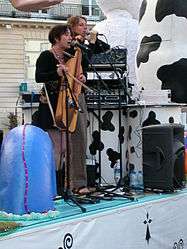Ütőgardon
The ütőgardon, also called a gardon, is a folk musical instrument played primarily in Transylvania. It is similar in appearance to a cello, but it is played percussively like a drum. Instead of being played with a bow, its strings are plucked and beaten with a stick.
 A person playing the ütőgardon. | |
| String instrument | |
|---|---|
| Other names | gardon |
| Classification | bowed chordophone |
| Hornbostel–Sachs classification | 321.322 |
| Related instruments | |
| cello | |
Culture and use
The gardon was primarily played by the Székelys, a Hungarian ethnic group in Transylvania,[1] and the Csángós of the Gyimes region.[2] It can have three or four strings, usually tuned to D and d. Playing with a stick instead of a bow provides a droning accompaniment.[1] Musically there are some similarities between the violin-gardon ensembles of Hungarians and some Roma in Transylvania and the zurna-davul widespread throughout the Balkans, Anatolia, and the Near East. The gardon is regularly, though not exclusively, played by a woman, the wife of the violinist.[3]
See also
References
- Szendrei, Janka (2009). "Hungary". Grove Music Online. Oxford University Press. Retrieved 18 Sep 2014.
- Kurti, Laszlo. "The Way of the Taltos: A Critical Reassessment of a Religious-Magical Specialist" (PDF). Cite journal requires
|journal=(help) - Wilkinson, Iren Kertész (2009). "'Gypsy' [Roma-Sinti-Traveller] music". Grove Music Online. Oxford University Press. Retrieved 18 Sep 2014.